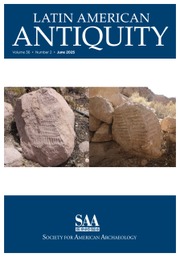Article contents
Estudio del nicho isotópico de cazadores-recolectores del centro-oeste de Santa Cruz, Argentina, durante el Holoceno tardío
Published online by Cambridge University Press: 29 June 2023
Resumen
Este estudio contribuye al entendimiento de la interrelación entre cambio ambiental, modificaciones en las estrategias de subsistencia y movilidad de grupos cazadores-recolectores, y la incorporación de nuevas tecnologías de captura y procesamiento de recursos durante el Holoceno tardío en el centro-oeste de Santa Cruz, Patagonia meridional, Argentina. Se presentan valores inéditos de δ13C sobre apatita y valores de δ15N y δ13C sobre colágeno de 42 individuos recuperados en estructuras de entierros con diferentes cronologías. Se utilizó el concepto de nicho isotópico para entender las continuidades y/o cambios de la dieta cazadora-recolectora. Se evaluó si hubo variaciones temporales y sexuales entre los nichos isotópicos de los individuos con patrones diferentes de organización social y económica en momentos previos y posteriores a los 900 años aP. Los resultados indican cambios en la dieta en los últimos 1.000 años, lo que se plasmó en valores más bajos en δ13Capa de los individuos enterrados en los chenques tardíos y, en particular, en las mujeres. De esta manera, la información paleodietaria apoya la hipótesis de modificaciones en el nicho isotópico a través del tiempo.
Abstract
This study contributes to the understanding of the interrelationship between environmental change, modifications in the subsistence and mobility strategies of hunter-gatherer groups, and the incorporation of new technologies for resource capture and processing during the late Holocene in southern Patagonia. We present unpublished δ13C values on apatite and δ15N and δ13C values on collagen from 42 individuals recovered in central-western Santa Cruz, Argentina. The individuals were recovered from burial structures with different chronologies during the Late Holocene. The concept of isotopic niche was used to understand the continuities and/or changes in the hunter-gatherer diet. The aim was to evaluate whether there were temporal and sexual variations between the isotopic niches of individuals who present different patterns of social and economic organization at times before and after 900 years BP. The results indicate that there was a change in their diet in the last 1,000 years, which was reflected in lower values in δ13Capa of individuals, particularly women, buried in late chenques. Thus, the paleodietary information analyzed and presented here supports the hypothesis of isotopic niche modifications through time.
Keywords
- Type
- Article
- Information
- Copyright
- Copyright © The Author(s), 2023. Published by Cambridge University Press on behalf of Society for American Archaeology
References
Referencias citadas
- 2
- Cited by


